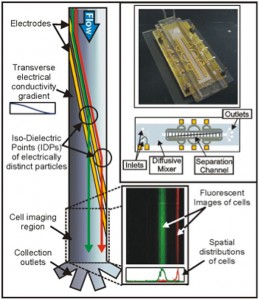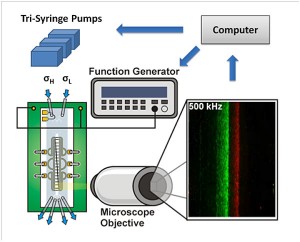Iso-dielectric Separation of Cells and Particles
- Category: MEMS & BioMEMS
- Tags: Hao-wei Su, Joel Voldman
The development of new techniques to separate and characterize cells with high throughput has been essential to many of the advances in biology and biotechnology over the past few decades. Continuing or improving upon this trend – for example, by developing new avenues for performing genetic and phenotypic screens – requires continued advancements in cell sorting technologies. Towards this end, we are developing a novel method for the simultaneous separation and characterization of cells based upon their electrical properties. This method, iso-dielectric separation (IDS), uses dielectrophoresis (the force on a polarizable object [1] ) and a medium with spatially varying conductivity to sort electrically distinct cells while measuring their effective conductivity (Figure 1). It is similar to iso-electric focusing, except that it uses DEP instead of electrophoresis to concentrate cells and particles to the region in a conductivity gradient where their polarization charge vanishes [2] [3] [4] .
Previously, we have demonstrated the ability to perform continuous-flow, label-free, non-binary separations using IDS on a wide variety of cells and particles, while simultaneously extracting quantitative information from these samples as they are sorted [4] . In order to make IDS discovery more unknown cell types, dynamically changing the conductivity gradient is crucial for increasing the efficiency of finding the optimal separation condition. Therefore, we are developing a tri-syringe pump system to dynamically control conductivity gradients. We have verified the stability of the tri-syringe pump system via quantitative fluorescence imaging. Combining this gradient control system with a computer-controlled function generator and automated microscope, we plan to fully automate IDS separation and electrical profile screening (Figure 2).
- Figure 1: Iso-dielectric separation. The spatial conductivity gradient makes cells with different electrical properties pass through the electrodes at different positions.
- Figure 2: Automated iso-dielectric separation system. We have developed a tri-syringe pump system that enables the real-time control of the electrical conductivity gradient with stable long term and short term response.
- H. A. Pohl and J. S. Crane, “Dielectrophoresis of cells,” Biophysical Journal, vol. 11, pp. 711-727, 1971. [↩]
- M. D. Vahey and J. Voldman, “An equilibrium method for continuous-flow cell sorting using dielectrophoresis,” Analytical Chemistry, vol. 80, no. 9, pp. 3135-3143, 2008. [↩]
- M. D. Vahey and J. Voldman, “Iso-dielectric separation: A new method for the continuous-flow screening of cells,” Micro Total Analysis Systems ’06, vol. 2, pp. 1058-1060, 2006. [↩]
- M. D. Vahey and J. Voldman, “High-throughput cell and particle characterization using isodielectric separation,” Analytical Chemistry, vol. 81, no. 7, pp. 2446-2455, 2009. [↩] [↩]

